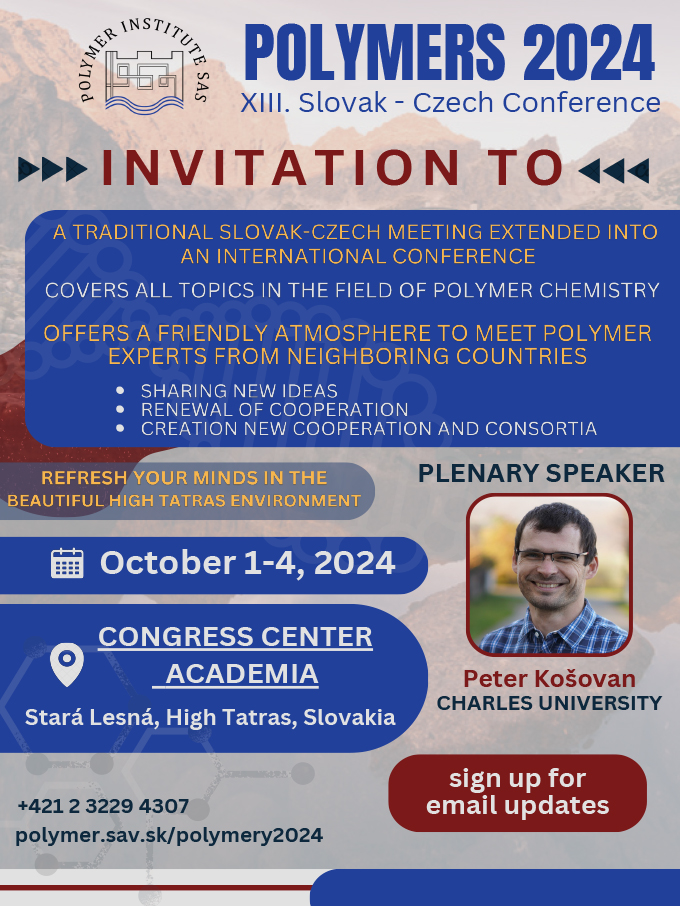FREMACH TRNAVA, s.r.o. - Impact of viscosity for filling of the injection mold cavity
The aim of this work is to bring closer the rheological properties of plastics and their impact on technology in the plastics processing industry. The paper focuses on the influence of the viscosity of the material for filling the mold cavity. 4 materials are tested with the settings of process parameters with different viscosity. Using simulation software Moldex3D we can see what effect a change in viscosity of the material to be filling.
Rheology is the science that deals with the deformation of the material to which force is applied. The term is most commonly used in the study of liquids and liquid-like materials, i.e. all materials that flow, rheology, however, also includes the study of deformation of solids, such as occur for example when working metal or pulled rubber. Two key words in the above definition are rheology deformation and strength. To learn something about the rheological properties of the material must either measure the deformation resulting from the forces, or to measure the force required to achieve the observed deformation. For a linear elastic material or a Newtonian fluid is a simple observation sufficient to have a general equation that describes how the materials react to any type of deformation. Such an equation is called a constitutive or rheological equation of state. However, for more complex materials such as molten plastic, is the creation of constitutive equations is much more complex task that may require the results of many types of experiments. The second aspect is the development of rheology relationships that show how the rheological behavior of the affected structure, material composition and the temperature and pressure. In the case of more complex materials can develop a relationship showing how specific rheological properties such as viscosity and relaxation modulus influenced by the molecular structure, composition, temperature and pressure. The molten plastic in a fluid state are rheologically complex materials that can exhibit properties such as viscous flow and elastic recoil. General constitutive equation has been developed primarily for these materials and the current state of knowledge of their rheological behavior is largely based on empirical research. This fact on the one hand complicates description and measurement of the rheological properties, but on the other hand, makes the plastic rheology relatively new and interesting science (1).
Rheological properties
The rheological characteristics of the material features which significantly influence the shape and flow of the material. They also called flow properties. The mathematical representation is the following flow curves, which expresses the dependence of the shear stresses shear strain rate of the material. The flow of polymer materials during their processing is pseudoplastic and largely differs from the flow of low molecular weight liquids (2). One of the main differences between the low molecular weight fluids which are also called Newtonian, and, high molecular compounds, which are referred to as non-Newtonian, the viscosity. By physical Oxford dictionary is defined as the viscosity value expressing the size of the internal friction in the liquid, measured as the amount of force exerted per unit area of the resistance extending flow (3). More generally, the viscosity is a material property that describes its resistance to creep. Liquid resists the movement of the layers of particles with different speeds. It's also the most common rheological measurement and the identification value, but it is qualitatively different feature for Newtonian and non-Newtonian fluids . Mathematically, the viscosity can be defined as the ratio of shear stress and shear rate (4).
In view of the rheology of the fluid thus divided by the viscosity at:
• Newtonian - liquid low molecular weight, to describe the rheological behavior during shear is applied Newton's law. Viscosity for Newtonian substances material constants is independent of time and speed shear deformation depends only on the temperature, pressure and molecular properties of the test substance (5).
• Non-Newtonian - high-molecular liquid, the flow of which is independent of time. Their viscosity is not constant, but depends on the strain rate. To describe their behavior using various mathematical models, but particularly power law. The flow properties of non-Newtonian fluids are described by rheogram.
• The behavior during the flow of non-Newtonian substance subdivided into:
- Viscoplastic,
- Dilatant.
Newtonian fluid behavior can be caused by several factors related to the structural reorganization of the molecules of the material as a result of the material flow. The polymeric substances and compounds is the cause of reducing the viscosity of highly anisotropic arrangement of chains (7).
Factors influencing the rheological properties
Shear stress • - represents the ratio of the shear force acting on a unit area,
• Shear rate - change of shear strain versus time.
• Temperature - significantly affects the viscosity,
• Pressure - affects the free volume between the particles
• Molecular weight and structure - the arrangement of the macromolecules of the melt depends on the behavior of the plastic,
• additives - chemical composition of the material affects its behavior during processing (4).
Importance of rheological properties in the simulation of injection
The first injection of plastic into the mold always precedes the simulation, which should identify possible problems and shortcomings caused by the parameters selected, as well as the choice of material. The simulation parameters are important, as well as injection of the selected material, and thus on the most accurate simulation of the outputs it is necessary to select the values, including the rheological properties so as to achieve the best quality and the final shape of the product.
For the purpose of determination of rheological impact of its properties to the resulting shape of the second burst, we will compare the simulation results for four different polymeric materials used for the injection under the same conditions in the mold cavity of the same shape.
Draft model components
As a model for simulation of the injection component, we have proposed a flat rectangular shape, wherein the holes are rectangular. These are important to evaluate and compare the degree of filling of the molds. We construct a model components in SolidWorks method CSG. First, we are in sketch mode draw a rectangle measuring 150x46 mm. We then pull it out to a height of 4 mm formed solid. Rectangular hole we created a Boolean operations. To create parts can be seen in Figure 1. The finished component, we exported in STEP format.
 | |
Figure 1: Create a 3D part model in SolidWorks |
Selection and material parameters
Tab. 1 Basic characteristics of selected materials
Material | Density [g.c-3] | Modulus of elasticity [MPa] | Yield strength [MPa] | Melt temperature [°C] | Pour point [°C] |
PA66 Ultramid 1003-2 | 1,14 | 3000 | 85 | 280-305 | 252 |
PC ST5201V | 1,20 | 2400 | 66 | 280-320 | 163 |
PC XQ83619 | 1,32 | 2800 | 65 | 280-300 | 160 |
POM Ultraform E3320 | 1,40 | 2700 | 64 | 180-220 | 170 |
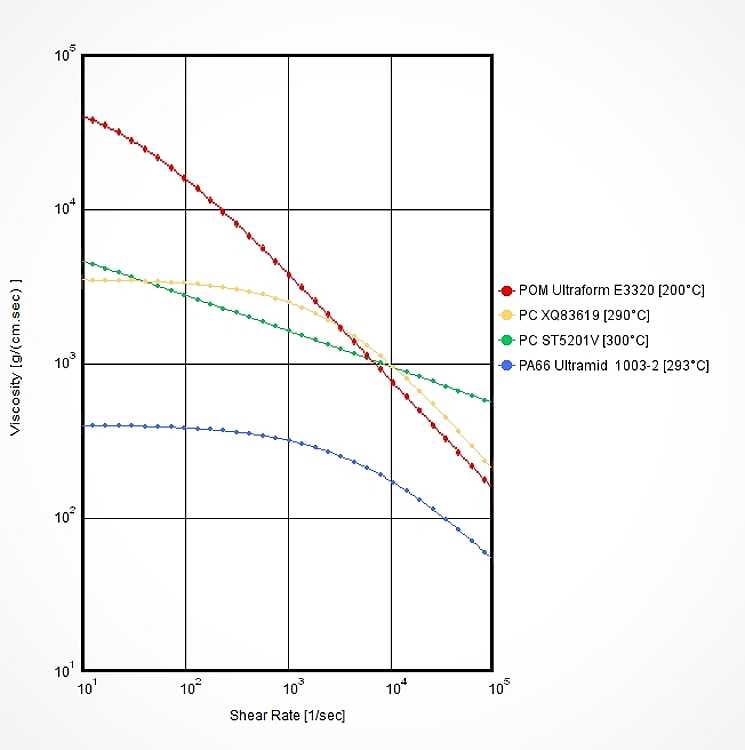 | |
Figure 2: Graphical representation of medium viscosity materials |
Machine selection and injection parameters
As a machine suitable for the production of parts, we designed based on the parameters chosen Injection Engel ES 200/65. In the SolidWorks program, we have found that the volume part is 8.8 cm-3, the dimensions are 150x46 mm and a height of 4 mm. Comparing these values with the values in Table 2, we see that in the case of one-dimensional form Machine clearly meets the specifications required for the production of the proposed part.
Tab. 2 Basic parameters of the selected injection molding machine
Parameter | Value | Unit |
Clamping force | 650 | Kn |
Screw diameter | 25 | mm |
Maximum injection volume | 68 | cm3 |
Diameter of center ring | 125 | mm |
ejectors | 100 | mm |
Size of clamping plate | 570x552 | mm |
Maximum range | 430 | mm |
Height of mould | 150 | mm |
Simulation of injection in Model 3D environment
Simulation of injection molding to form was implemented in an environment Moldex 3D R13.0. Moldex 3D CAE software is designed for execution of simulation of injection molding. It offers a wide range of analyzes for different processing liquid plastic. The simulation takes place on the finite element model that can be constructed directly in the environment of Moldex-in, or we can use the model exported from any CAD software in STEP format.
First, we then imported the model that we have before created in SolidWorks. We then selected the appropriate solver for 3D solid model and chosen way of injection technology. Then we chose the material and process parameters injection. The middle of the shorter sidewall inlet point we placed a small diameter. Finally, we ran an analysis. We repeated this process four times to the fact that the model and the parameters of the simulation were the same of each of the materials selected.
Evaluation of the simulation
Conditions of melt as we compare the selected material at the end of the injection cycle of approximately 4 seconds. After this period, the action of constant pressure bar 50 starts to face the melt to solidify, so that the extension of the injection time is not relevant. The actual injection cycle times are slightly different, the order of a hundredth of a second, for the Unification of evaluation results, we have chosen the same time for all materials.
First, check the value of simulation, shear rate and shear stress.
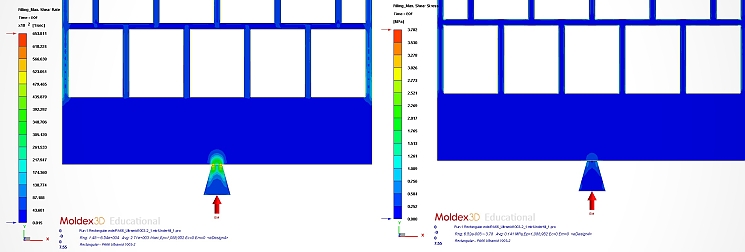 | |
Figure 3: Shear rate and shear stress in the component cross section from the material Ultramid10032 |
Ultramid 1003-2 reaches shear maximal speed 65381,1 s-1 which are on the edge of flow apertures and sliding pressure is in this place 0,8MPa. That makes viscidity approximately 12Pas.
 | |
Figure 4: Shear rate and shear stress in the component cross section from the material PC ST5201V |
PC ST5201V reaches shear maximal speed 60634,3 s-1.which are on the edge of flow apertures and sliding pressure is in this place 3,87MPa. That makes viscidity approximately 64Pas
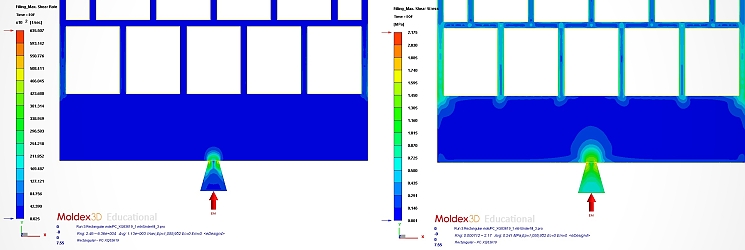 | |
Figure 5: Shear rate and shear stress in the component cross section from the material PC XQ83619 |
PC XQ83619 reaches shear maximal speed 63550,7 s-1 which are on the edge of flow apertures and sliding pressure is in this place 2,175MPa. That makes viscidity approximately 34Pas.
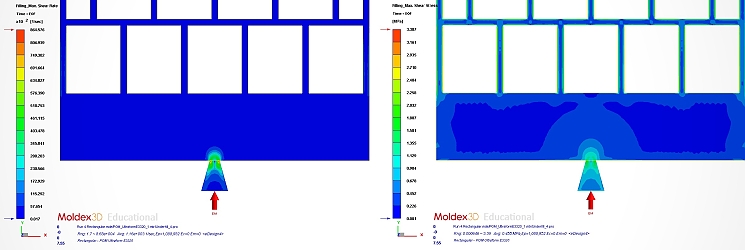 | |
Figure 6: Shear rate and shear stress in the component cross section from the material POM UltramidE3320 |
POM UltramidE3320 reaches shear maximal speed 86457,6 s-1 which are on the edge of flow apertures and sliding pressure is in this place 3,387 Pa. That makes viscidity approximately 39Pas.
The biggest sicdidity has material PC_ST5201V and in the selected area appoximately 64Pas. Therefore it has the highest assumption to fill the component the least, and right after is followed by material POM UltramidE3320, which has in given point visdidity 39Pas. The material PC_XQ83619 with viscidity 34 Pas could be filled more. Out of mentioned materials in the given area the lovest viscidity is for plastic Ultramid 1003-2 approximately 12Pas. Therefore there are highest assumptions to fill the component the least.
Simulation of fillings revealed how the components were really filled
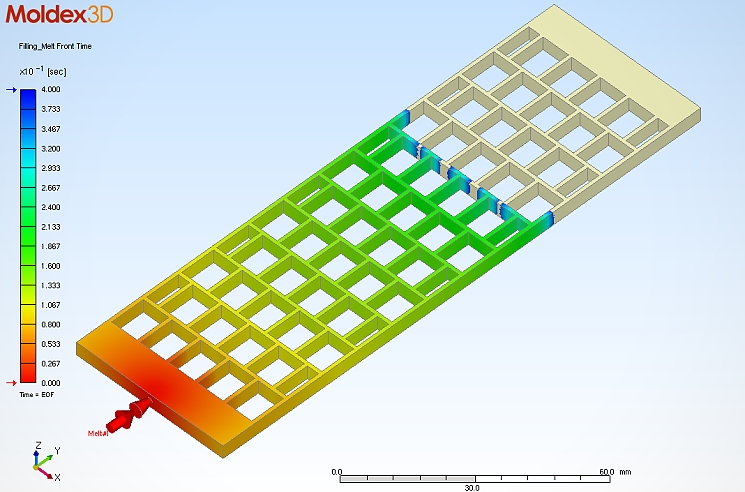 | 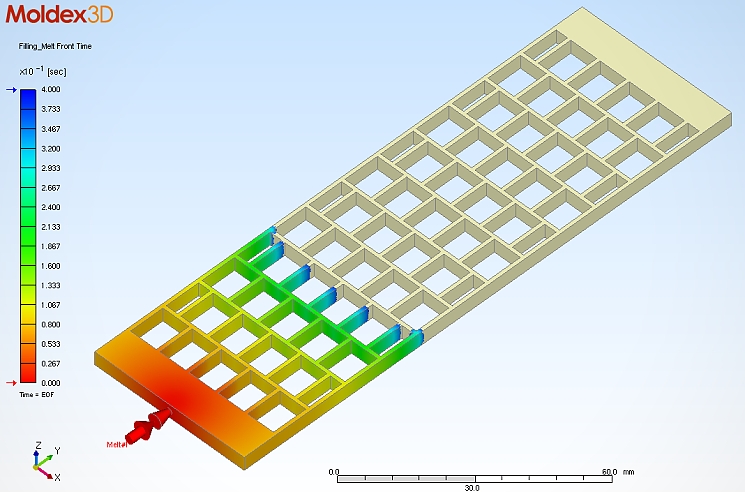 |
Figure 7: Status PA66 Ultramid 1003-2 in the mold cavity at the end of the injection cycle | Figure 8: Status PC ST5201V the melt in the mold cavity at the end of the injection cycle |
From Figure 7 we see that the material fill the almost 66% of the mold cavity. The four materials of the selected PA66 Ultramid 1003-2 lowest viscosity, we can therefore be expected to fill the form to a substantially greater extent than the other three plastic. This supposition confirmed by simulation. Figure 8 shows the state of filling mold material ST5201V PC, which reached approximately 30% of the total form. Because this material has a considerably higher viscosity than Ultramid PA66 1003-2, we assumed that it fills the form in the lower range.
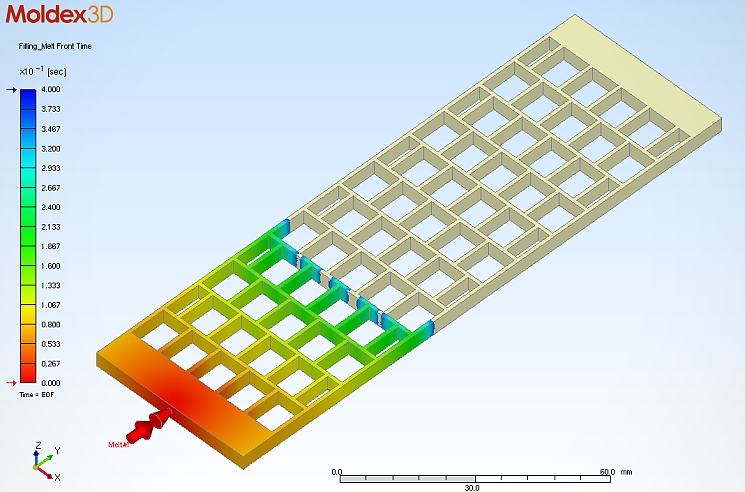 | 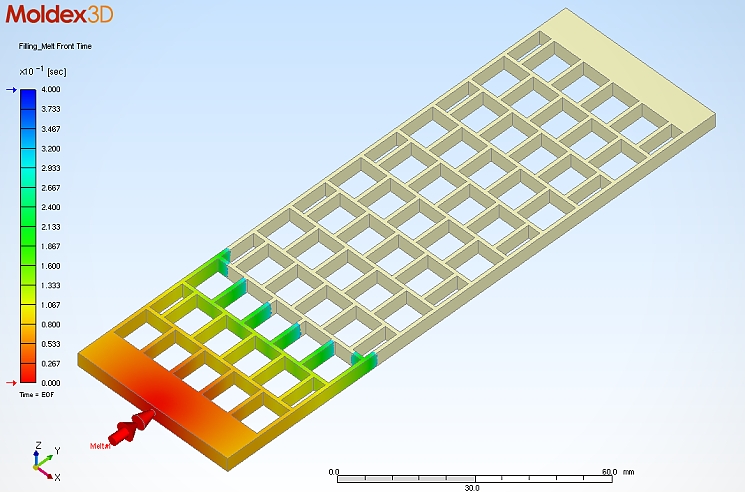 |
Figure 9: Status PC XQ83619 in the mold cavity at the end of the injection cycle | Figure 10: Status POM Ultraform E3320 in the mold cavity at the end of the injection cycle |
Figure 9 shows the fill material form XQ83619 PC. And it did fill the mold about 33%, only slightly more than ST5201V PC, which is due to the comparative value of medium viscosity materials both expected due. We could conclude that, despite the different nature of the two medium viscosity polycarbonates is the difference in the flow and filling as a minimum, a more important factor than the character viscosity value, respectively. like viscosity values. The rate of filling the mold POM Ultraform E3320 is shown in Figure 10. We see that the result of significantly higher viscosity compared to the other materials used to fill the mold at the lowest rate, only about 23%. Compared to PC material XQ83619 respectively. ST5201V PC is not as rapid decline as compared with those of polycarbonate, polyamide PA66, even though the difference values of medium viscosity are comparable.
Simulation of filling has confirmed the assumption that component with material Ultramid 1003-2 is filled the most. Also was confirmed that materials POM UltramidE3320 and PC ST5201V fill the component the least.
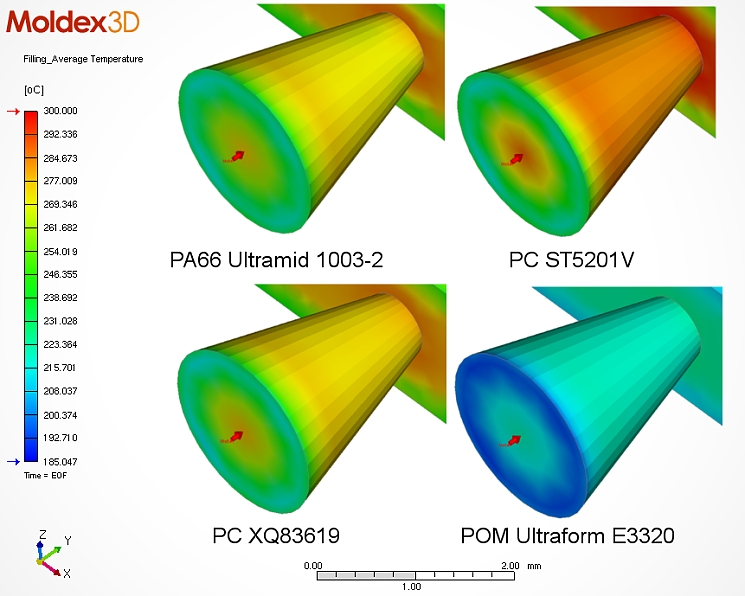 | |
Figure 11: Temperatures of the inlets at the end of the injection cycle |
On Figure 11 we can see the average temperature of the inlet 4 for all the materials at the end of the injection cycle. To subtract the approximate values of temperature on the color of the scale, and compares the values as indicated in Table 1, we can conclude that in all four cases, the material is below the melting temperature. Holding pressure is therefore not possible, and the state of filling the mold material is finite. Comparing the preceding figures and their recovery in relation to the viscosity of each material, we can say that the viscosity, as the most important rheological property of the plastic melt during the injection molding process has a significant impact on the flow of material as well as a degree of filling of the molds. Complete filling of the mold we have not achieved in either case, the solution could be to change the shape of parts, change injection parameters, or selecting suitable materials with lower viscosity. We estimate that material with about half the size of medium viscosity value as Ultramid PA66 material 1003-2 would be able to fill up the form without changing the form of parts or change injection parameters.
Conclusion
Based on this simulation, we can study how they affect the rheological properties of four different types of plastics using the same mold cavity and injection parameters on the final parts. We found that the material Ultramid PA66 1003-2, which had the lowest viscosity reached a top speed of melt flow rate and fill the mold and melt flow POM Ultraform E3320, which was about two times higher than PA66 medium viscosity, was the slowest. If you do the comparison includes resources XQ83619 PC and PC ST5201V, we can conclude that the ratio of the viscosities and degree of filling forms are not directly proportional, to determine their relationship would have required a large number of materials simulation. The results of the simulations carried out, however, clearly shows that the viscosity of the molten material significantly affects the final product injection and is an important parameter that should be considered when selecting the material for injection molding.
References:
- DEALY J., WISSBRUN K. Melt rheology and its role in plastics processing. New York: Van Nostrand Reinhold, 1990. 665 s. ISBN 13-978-1-4615-9740-7
- ZEMAN L. Vstřikováni plastů. BEN - technická literatura, Praha, 2009. 238 s. ISBN 978-80-7300-250
- OXFORD DICTIONARIES. Definition of viscosity. [online] 2016. [cit. 2016-4-3]. available on internet: https://www.oxforddictionaries.com/definition/english/viscosity
- JAHNÁTEK Ľ., GROM J., NÁPLAVA A. Teória a technológia spracovania plastov. Bratislava: Slovenská technická univerzita, 2005. 188 s. ISBN 80-227-2256-1
- UNIVERZITA TOMÁŠA BAŤU V ZLÍNE. Tokové chování polymerních tavenin – reologické modely. Ústav fyziky a materiálového inženýrství UTB. [online] 2010. [cit. 2015-29-11]. Dostupné na internete: http://ufmi.ft.utb.cz/texty/fyzika_pol/FP_02.pdf
- VAVRO K., PECIAR M. Procesné strojníctvo I. Vydavateľstvo STU, Bratislava, 1998. ISBN 80-227-1030-X
- RHEOSENSE. Viscosity of Newtonian and non-Newtonian Fluids. [online] 2016. [cit. 2016-5-2]. Available on internet:http://www.rheosense.com/applications/viscosity/newtonian-non-newtonian
- autor:
- Ing. Lukáš SATIN, PhD.





















